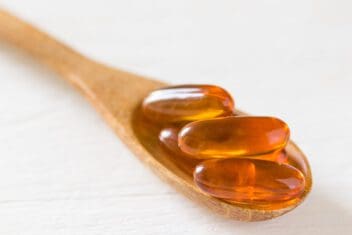Do Flaxseed Oil and Fish Oil Relieve Dry Eyes?
Home / Dry Eyes: Causes, Symptoms & Treatments /
Last Updated:
Flaxseed oil and fish oil are rich sources of omega-3 fatty acids. Omega-3s are very popular in treating a number of conditions, including dry eye.
Table of Contents
The fatty acids in flaxseed and fish oil may help dry eye conditions by reducing inflammation, improving eye gland tear production, and regulating hormones that may cause dry eye symptoms.
Some studies and medical organizations support the theory that omega-3 fatty acids are beneficial in treating dry eye problems. However, a recent study published in the New England Journal of Medicine concluded that the fatty acids had no effect on dry eye conditions.

Because they may contain other, complementary nutrients, whole foods and freshly pressed oils are the best ways to consume omega-3 fatty acids.
While flaxseed and fish oil are relatively safe and risk-free, it’s important to discuss any dry eye conditions with a medical professional. Dry eyes may be a symptom of a more serious eye or vision disorder that is likely easier to treat with earlier detection.
Why Do People Use Flaxseed Oil and Fish Oil to Relieve Dry Eyes?
Flaxseed oil and fish oil are solid sources of omega-3 fatty acids — essential fatty acids that are essential for optimal health and body function. Humans do not produce these essential fatty acids on their own. Instead, they must be consumed through diet.
Three of the most desired fatty acids are ALA (alpha-linolenic acid), DHA (docosahexaenoic acid), and EPA (eicosapentaenoic acid).
You deserve clear vision. We can help.
With 135+ locations and over 2.5 million procedures performed, our board-certified eye surgeons deliver results you can trust.
Your journey to better vision starts here.
While research on omega-3s is ongoing, and some feel that their benefits are exaggerated, there has been ample research to indicate that omega-3 fatty acids offer a number of health benefits, especially when sourced from whole and fresh foods.
For these reasons, omega-3 fatty acids have become a popular health trend. In recent years, these nutrients have been researched extensively and received plenty of good press for offering beneficial treatment for everything from depression to cancer. According to the Nutrition Business Journal, fish oil products alone accounted for about $1.2 billion in sales in 2013.
Many supplements also market formulas for dry eyes that contain omega fatty acids. A quick internet search for natural dry eye supplements will pull up a number of companies offering various treatments containing fatty acids, many with omega right in their name.
Of course, supplements aren’t the only source of omega fatty acids. Whole foods like eggs, nuts, and certain types of oily fish are abundant in omega-3 fatty acids. Many people who are looking to treat their dry eyes with essential fatty acids choose to get their nutrients this way.
How Do Flaxseed and Fish Oils Treat Dry Eyes?
Dry eye happens when the quantity or quality of tears produced by the eye can’t keep its surface properly lubricated. Symptoms can include itching, irritation, stinging, and blurred vision.

With the essential fatty acids they provide, flaxseed and fish oils may treat dry eye in the following ways:
- Reducing inflammation: Omega-3 fatty acids have been shown to reduce inflammation. Oftentimes, the inflammation of the eyelids or surface of the eye can exacerbate dry eye conditions. By reducing inflammation, omega-3 acids can help to alleviate these symptoms.
- Improving function in the eye’s Meibomian glands: These glands produce the oily part of tears, and their improved function can help to alleviate dry eye symptoms.
- Helping to regulate hormones and blood sugar levels: Hormonal issues may be a cause of dry eye symptoms. Research indicates that omega-3 acids have a balancing and beneficial effect on hormones as well as on blood sugar levels, which can also affect eye health.
Fish Oil vs. Flaxseed Oil
Flaxseed and fish oils each contain omega-3 fatty acids considered essential to maintaining good health, but they are not the same thing. Flaxseed oil is rich in alpha-linolenic acid (ALA), while the fish oil contains eicosapentaenoic acid (EPA) and docosahexaenoic acid (DHA).
For people who consume flaxseed oil, the body converts ALA to EPA or DHA, an active form of omega-3. The conversion process is inefficient in humans. Fish oil offers greater benefits than flaxseed oil in preventing heart diseases, promoting skin health and reducing inflammation.
Both of these omega-3-rich oils play a significant role in treating various eye conditions, including dry eyes. A current study shows that the use of omega-3 alleviates dry eye symptoms in patients with the Rosacea virus.
Because fish and flaxseed oils contain varying amounts of essential fatty acids, the amount required to treat eye problems differs. Experts generally recommend taking 1,000 mg of omega-3 acids daily to gain the maximum health benefits from them.
Are They Actually Helpful In Treating Dry Eyes?
There are conflicting research and opinions in the medical world about whether or not flaxseed oils and fish oils, and omega-3 fatty acids in general, are beneficial in treating dry eyes.
Some studies, including a 2005 Women’s Health Study and a 2013 study published in the International Journal of Ophthalmology, have concluded that these essential fatty acids are effective in treating dry eyes. Medical Organizations like the National Eye Institute and the American Academy of Ophthalmology have also stated publicly that omega-3 fatty acids are beneficial in treating dry eye conditions.
However, a more recent study in the New England Journal of Medicine, published in 2018, found that omega-3 fatty acids were no more effective in treating dry eye disease than a placebo.
You deserve clear vision. We can help.
With 135+ locations and over 2.5 million procedures performed, our board-certified eye surgeons deliver results you can trust.
Your journey to better vision starts here.
What Are the Best Sources of Flaxseed and Fish Oil?
While there is some conflicting research on whether or not omega-3 fatty acids are effective in treating dry eye conditions, most medical and nutrition experts agree that these fatty acids are essential to human health and beneficial for many conditions when they’re derived from the right source.

Flaxseed and fish oil are no exception. Both are excellent sources of omega-3 fatty acids, but what’s the best way to consume them?
Many supplements contain these fatty acids, and the fatty acids themselves are available in pill or gel tablet form. But the supplement market is largely unregulated, and consumers don’t always get what they pay for.
Many would say that eating whole foods that contain these oils — like fresh cold-pressed flaxseed oil (available refrigerated in many health food markets) for flaxseed oil or a freshly cooked oily fish (like trout) for fish oil — is the best way to get the essential oils. By eating whole foods, you are getting not only the ALA or DHA, but also the other nutrients that are naturally supplied in these foods, which may boost their effectiveness.
Other Supplements That Help with Dry Eyes
Apart from the omega-3 laden fish and flaxseed oils, vitamin supplements can help reduce dry eye symptoms. Vitamin A, B12, D and E are locally available supplements that you can use with other treatments to manage dry eyes (2).
Despite the potential benefits of these supplements, their effect is minimal when used alone. As a result, you need to adhere to your doctor’s recommendations as you take the supplements.
Should a Doctor Be Consulted Before Taking Flaxseed and Fish Oil?
Flaxseed and fish oil are natural. If no allergies are present, they offer little risk or danger when consumed from whole foods or alone as a supplement from a reputable brand. However, consulting a medical professional can be helpful when starting any new regimen.
Any dry eye symptoms should be discussed with a medical professional, as they may indicate a more serious vision or eye health problem. Many eye conditions have subtle symptoms, and all are much easier to treat in the earlier stages, so early detection is key.
You deserve clear vision. We can help.
With 135+ locations and over 2.5 million procedures performed, our board-certified eye surgeons deliver results you can trust.
Your journey to better vision starts here.
References
- 17 Science-Based Benefits of Omega-3 Fatty Acids. (October 15, 2018). Healthline.
- What Are Omega-3 Fatty Acids? Explained in Human Terms. (October 25, 2015). Healthline.
- A Randomized Controlled Trial of Omega-3 Fatty Acids in Dry Eye Syndrome. (December 18, 2013). International Journal of Ophthalmology.
- The Relationship Between Dietary n-3 and n-6 Fatty Acids and Clinically Diagnosed Dry Eye Syndrome in Women. (October 2005). American Journal of Clinical Nutrition.
- The Research Backing Up the Health Benefits of Omega-3’s is Fishy. (September 24, 2012). Business Insider.
- n-3 Fatty Acid Supplementation for the Treatment of Dry Eyes. (May 3, 2018). The New England Journal of Medicine.
- Facts About Dry Eye. (July 2017) National Eye Institute (NEI).
- 12 Natural Ways to Balance Your Hormones. (May 15, 2017). Healthline.
- Fish Oil: Friend or Foe? (July 12, 2013). Harvard Medical School.
- What’s in Your Fish Oil Supplements? (January 22, 2014). The New York Times.
- Why not flaxseed oil? (July 19, 2019). Havard Health Publishing.
- Omega-3s & other vitamins may improve dry eye — here’s what the research says. (January 14, 2021) Insider.
This content is for informational purposes only. It may have been reviewed by a licensed physician, but is not intended to serve as a substitute for professional medical advice. Always consult your healthcare provider with any health concerns. For more, read our Privacy Policy and Editorial Policy.
